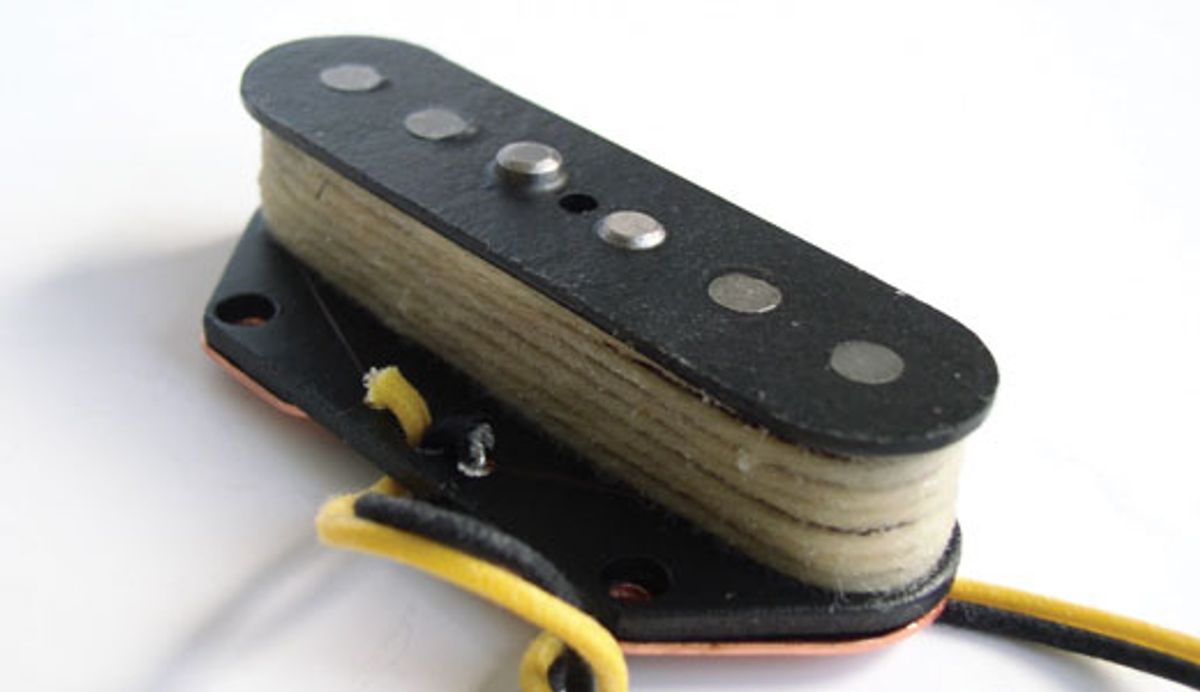
A traditional Tele single-coil with a pentagonal, copper-coated soft-iron baseplate and staggered alnico magnets. Photo courtesy of LeoSounds Pickups (leosounds.de)
Before you replace your Telecaster’s bridge pickup, it’s important to understand the commonly available designs, how they differ, and what sonic purpose each serves.
We're in the process of exploring the sonic and design evolution of Telecaster bridge pickups. Previously we looked at three categories of the earliest types: '50s lap steel, Broadcaster/Nocaster, and '50s vintage [“Exploring the Tele Pickup Palette," April 2014]. Let's continue our journey.
Sixties vintage. In comparison to the '50s vintage design, the '60s vintage-type bridge pickup offers even more high end for a twangier sound with a lot of snap. This is due to the pickup's construction (less DC resistance and smaller diameter magnets compared to'50s pickups), but there are also several hardware-related factors that help create the typical '60s Telecaster lead tone. For example, '60s Teles used different bridge saddles (mostly steel, not brass) and had alder bodies. Eventually the electronics were altered as well: Fender began using 1 Meg ? pots and an over-calculated treble bleed network on the volume pot to prevent high-end loss when you rolled back the volume.
Because each of these elements contributes to the classic, penetrating '60s sound, you have to view the pickup in the larger context of the hardware and electronics that accompanied it. If you want to replicate this tone, it's important to also use the era's electronics. For all other applications, you'll benefit from using 250k pots and snipping off the miscalculated treble-bleed network. I'd also avoid bright-sounding strings and putting this '60s-style pickup on bodies made from such bright-sounding woods as basswood or maple.
The '60s-style bridge pickup is pure, powerful rock 'n' roll, especially when played with overdrive. (But choose a warm overdrive, fuzz, or distortion pedal.) This pickup also interacts perfectly with a tube amp and easily pushes it into saturation.
Vintage overwound. Designed for a hotter, vintage-flavored tone with enhanced output and midrange, a vintage overwound bridge pickup is ideal for blues, SRV-inspired blues-rock, and even Southern rock. It's also a great choice for taming an excessively bright guitar.
Almost every pickup company offers something in this ballpark. Perhaps the best known is the Fender Custom Shop Texas Special. Compared to standard models, a typical vintage overwound pickup has more winds (hence its name), and this is often paired with a different wire gauge. Because this design yields a more prominent midrange and a mellower tone, this breed of pickup is often described as “fat sounding," and its increased output drive your amp into saturation more readily. For many players, a vintage overwound pickup delivers the ideal combination of chime, output, and top end.
Avoid using an overwound bridge pickup on a dark-sounding guitar because this can lead to a surplus of midrange and a muddy tone. On typical Teles, 250k pots work great, but on a slightly darker guitar, 500k pots can be the way to go. Another great alternative: mixed sets of 250k volume and 500k tone pots.
Vintage overwound pickups react well to different string materials, so that's another way to sculpt your sound. Use an overdrive pedal with less prominent midrange—the pickups already have plenty. For tube overdrive, use the mid and presence controls on your amp to tweak your tone.
Pentagonal humbucker. Designed to drop into a Tele with absolutely no routing, these humbuckers consist of two coils in either a stacked or parallel configuration. Bridge humbuckers eliminate most of the typical single-coil hum and noise, and they increase your output because now you have twin coils wired in series. If you choose a model with 4-conductor wiring, you can also use a bridge humbucker in split mode (this yields a quasi-single-coil tone in all its noisy, humming glory) or with both coils wired in parallel for a hum-free, single-coil-like sound. That's three unique tones from one pickup.
Because of their small physical size, pentagonal bridge humbuckers “see" a smaller magnetic window than a full-sized humbucker. This gives them a brighter tone than their big brothers. Introduced in the '80s, Tele-sized humbuckers were made popular by DiMarzio and Seymour Duncan.
On bridge humbuckers with parallel coils (such as Duncan Hot Rails or Little '59s), the coils run side-by-side, just like on a standard humbucker. While these two coils are very narrow, they still “see" a wider window of the strings than a standard single-coil or a stacked humbucker (more about the latter in a moment). These pickups have either two rows of pole pieces or twin blades, and the way their magnetic fields react around the tops of the two coils results in a fatter tone than a single-coil bridge pickup. Most of these pickups are designed to mimic the tone of a PAF-style humbucker, so if this is your tonal goal, then side-by-side construction is your ticket to at least approximating the sound.
The second hum-cancelling design features stacked coils, with one coil on top of the other. Often called noiseless or vintage-stacked pickups, these incorporate slightly dissimilar phase-opposed stacked coils surrounded by metal sawtooth-shaped shielding to reduce hum. Though they're usually a tad deeper than true single-coil pickups, stacked-coil humbuckers have the same narrow magnetic window and therefore offer brighter, thinner tones than parallel-coil pickups. Stacking two coils changes tone by influencing the way the coils and the magnetic field react, so these pickups are not sonically identical to real single-coils—the design is always a compromise, and some models sound closer to true single-coils than others. This pickup type is perfect for players who seek single-coil tone without hum and noise. Examples of this design include Fender Noiseless and Kinman Zero Hum pickups.
Next time we'll examine another stash of Telecaster pickups. Until then, keep on modding!
